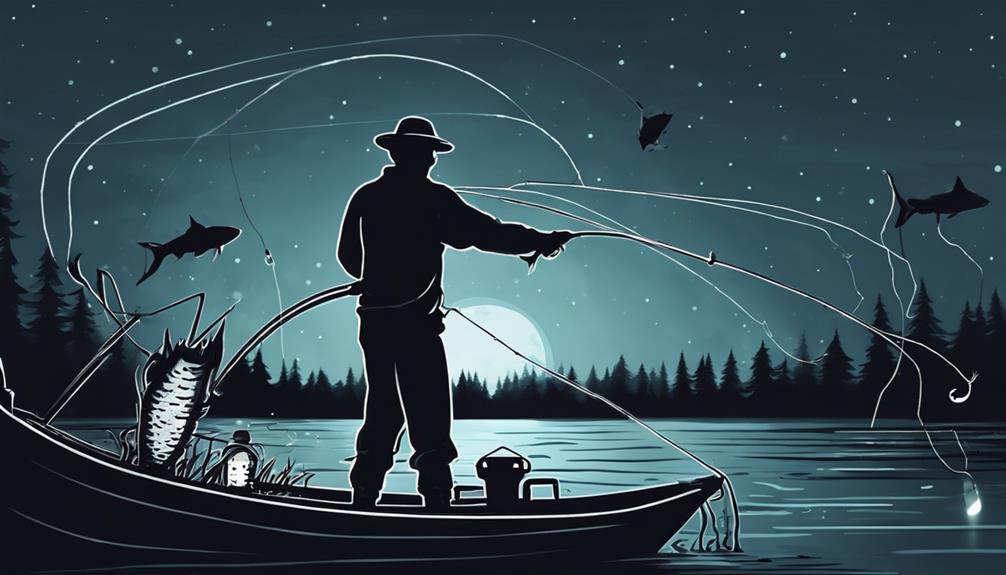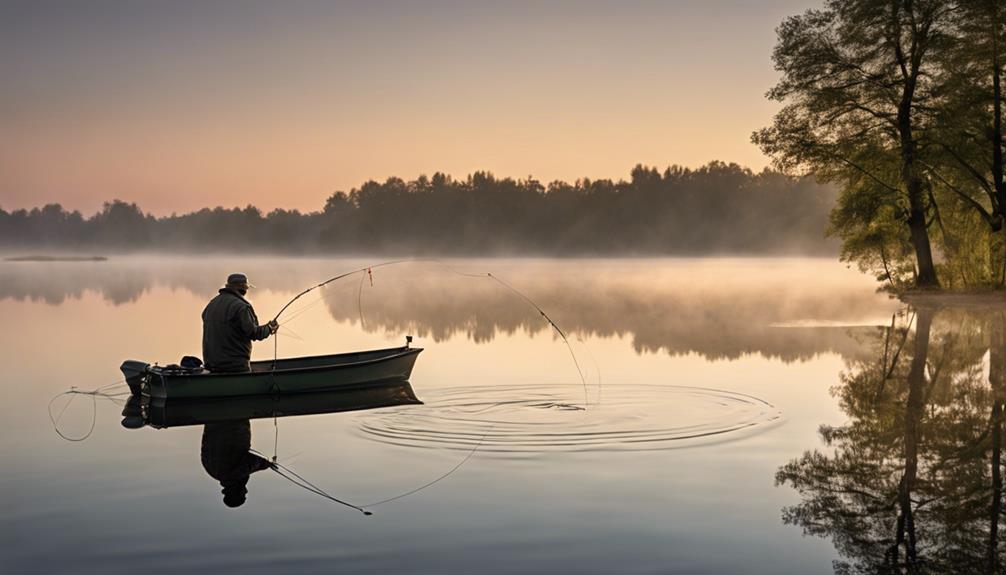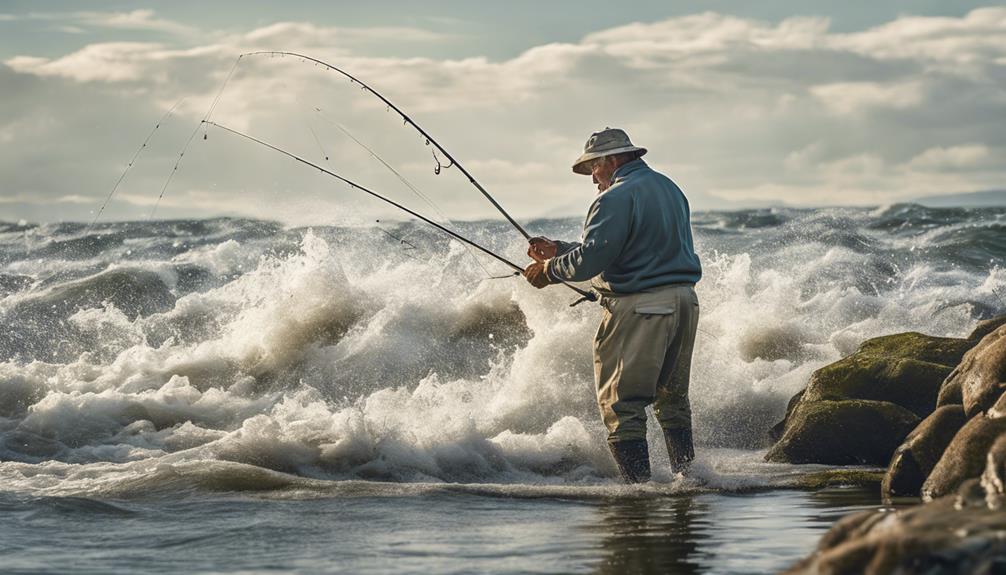Are you tired of coming home empty-handed after a night of catfish fishing?
Imagine the satisfaction of consistently reeling in those big cats under the stars.
By mastering proven techniques tailored for nighttime angling, you can significantly increase your chances of a successful catch.
From selecting the right bait to understanding the behavior of these elusive creatures, there's a whole world of strategies waiting for you to explore.
Best Bait Choices
Wondering what bait works best for night catfish fishing? When it comes to enticing those whiskered creatures under the moonlight, bait presentation plays a crucial role. Catfish are bottom feeders, so consider using baits that stay near the lake or riverbed. Opt for live bait like worms or minnows, ensuring they're securely hooked to withstand the catfish's powerful bite. Additionally, adjusting the bait presentation to match the water depth is essential. If you're fishing in deeper waters, use a heavier weight to keep the bait down where the catfish are lurking.
Another key factor in night catfish fishing is scent attraction. Catfish have an excellent sense of smell, so enhancing your bait with scents like blood or garlic can make a significant difference in attracting them. Before casting your line, consider soaking your bait in a scent attractant to maximize its effectiveness.
Moreover, choosing the right fishing line is crucial for a successful night fishing expedition. Opt for a strong and durable line that can withstand the weight and pull of a catfish. A braided fishing line is often preferred for catfish fishing due to its durability and sensitivity, allowing you to feel even the slightest nibbles in the dark waters.
Ideal Fishing Spots
For successful night catfish fishing, selecting ideal fishing spots is crucial for maximizing your chances of a good catch. When targeting catfish at night, two types of water bodies prove to be particularly promising: moonlit rivers and dark lakes.
Moonlit rivers are excellent locations for night catfish fishing. The gentle shimmer of moonlight on the water's surface attracts catfish, making them more active and easier to catch. Look for areas along the riverbank with overhanging trees or structures where catfish like to hide and wait for prey. These spots provide cover for catfish and increase your chances of a successful catch.
Dark lakes are another prime spot for night catfish fishing. Catfish are nocturnal creatures and feel more secure in the darkness of lakes during the night. Focus your efforts on areas with submerged structures like fallen trees, rocks, or underwater ledges where catfish tend to congregate. Using a fish finder can help you locate these underwater hotspots even in the dark.
Proper Equipment Setup
When setting up your equipment for night catfish fishing, ensure you have the right gear to maximize your chances of a successful catch. Start by carefully selecting your rod. Opt for a medium to heavy action rod that's sturdy enough to handle the weight and fight of a catfish. A good rod choice will provide the sensitivity needed to detect those subtle nighttime bites while having enough backbone to reel in the big ones.
In addition to rod selection, reel maintenance is crucial for a smooth fishing experience. Before heading out for your night fishing adventure, make sure your reel is in prime condition. Clean and lubricate it to prevent any potential malfunctions that could cost you a prized catch. Check for any wear and tear, and replace any worn-out parts to ensure optimal performance.
When setting up your rod and reel, spool your line correctly to avoid tangles and snags during the night. Make sure your drag is set appropriately to handle the strength of a catfish without breaking your line. By paying attention to these details in your equipment setup, you'll be better prepared to face the challenges of night catfish fishing and increase your chances of landing that trophy catfish.
Effective Casting Techniques
To improve your success in night catfish fishing, mastering effective casting techniques is essential. When casting your line out into the water, focusing on both distance and accuracy can significantly increase your chances of landing a catch. Here are some tips to help you enhance your casting skills:
- Casting Distance: To reach those elusive catfish lurking in the deeper waters, practice your casting technique to maximize distance. Ensure a smooth, powerful motion when releasing your line to cover more ground and access prime fishing spots.
- Accuracy: Catfish can be picky eaters, so being able to accurately place your bait near their feeding areas is crucial. Practice aiming for specific targets in the water to increase the likelihood of enticing a catfish to bite.
- Line Control and Retrieval Techniques: Once your line is in the water, maintaining control over it's vital. Keep a firm grip on your rod to feel even the slightest nibbles from catfish. When reeling in your catch, use steady, consistent movements to prevent the fish from escaping.
Understanding Catfish Behavior
Mastering effective casting techniques is crucial for night catfish fishing success; understanding catfish behavior will further enhance your chances of landing a catch. Catfish are known for their nocturnal habits, making night fishing particularly fruitful. Their feeding patterns often involve scavenging along the bottom of water bodies, seeking out prey like insects, smaller fish, and even aquatic plants. To capitalize on this behavior, consider using bait that mimics these natural food sources.
Catfish possess strong predatory instincts and employ various hunting strategies to secure their meals. They're opportunistic feeders, meaning they're likely to strike at bait that appears appetizing and easily accessible. When fishing for catfish at night, it's essential to position your bait strategically near their habitats, such as submerged logs, rock formations, or underwater ledges where they may be lurking.
Utilizing Night Fishing Lights
For optimal success in night catfish fishing, incorporating night fishing lights can significantly increase your chances of attracting and catching catfish. When using night fishing lights, consider the following tips:
- Light Color: The color of the light can play a crucial role in attracting catfish. Blue and green lights are generally more effective as they penetrate the water better than other colors. These colors attract zooplankton and insects, which in turn draw in smaller baitfish, creating a feeding frenzy that can lure catfish to your area.
- Light Placement: Proper placement of your night fishing lights is key. Position the lights just below the surface of the water to maximize their effectiveness. This placement helps create a distinct light line that attracts various aquatic organisms, making it easier for catfish to spot and ambush their prey. Additionally, placing the lights near structures like submerged logs or vegetation can further enhance their attractiveness to catfish.
- Light Movement: Consider using a floating light or attaching your light to a floating device to create movement on the water's surface. The ripples and fluctuations in light intensity mimic natural movements, making it more enticing for catfish to investigate and strike at your bait.
Managing Line Tension

When catfish are attracted to your strategically placed night fishing lights, ensuring proper management of line tension becomes crucial for a successful catch. To maintain optimal line tension, start by regularly checking your line for any signs of wear or damage. Line maintenance is key to preventing unexpected breaks during a big catch. Make it a habit to inspect your reel for any dirt or debris that could affect its smooth operation. Proper reel care not only ensures smooth casting and retrieval but also helps in maintaining consistent line tension.
In addition to line maintenance and reel care, tackle organization plays a significant role in managing line tension efficiently. Keep your gear neatly organized and stored to avoid tangles and knots that could lead to abrupt changes in tension. Utilize tackle boxes or bags with compartments to store different types of lines, weights, and hooks separately. This organized approach not only saves time but also reduces the chances of line entanglement, ensuring a smooth fishing experience.
Tips for Landing Catfish
To increase your success in landing catfish, focus on maintaining steady tension on the line throughout the fight. This is crucial in preventing the catfish from shaking the hook loose or breaking the line. Here are some essential tips to help you land catfish successfully:
- Catching Techniques:
When you feel a catfish on the line, set the hook with a firm and steady motion. Proper hook placement is key; make sure the hook is securely embedded in the catfish's mouth to avoid losing your catch during the fight. Keep your rod tip up to maintain pressure on the fish and prevent it from diving into cover.
- Reeling Strategies:
Use a smooth and consistent reeling motion to bring the catfish closer to you. Avoid jerky movements that could dislodge the hook. If the catfish makes a strong run, let it take some line while maintaining tension. Once it stops pulling, start reeling again to wear it out.
- Landing Net Use:
When the catfish is within reach, consider using a landing net to secure your catch. Gently guide the catfish towards the net and scoop it up smoothly. Be cautious, as catfish can put up a final struggle at the water's surface. A landing net can help prevent the catfish from breaking free just before you bring it ashore.
Frequently Asked Questions
How Can I Prevent Mosquitoes and Other Pests From Bothering Me While Night Catfish Fishing?
To keep mosquitoes and pests at bay while night catfish fishing, you can use natural repellents like citronella or essential oils. Ensure you have proper lighting to deter insects.
Set up a bug zapper away from your fishing spot to attract and eliminate pests. Wearing long sleeves and pants can also help protect you from bites.
Stay prepared and enjoy your fishing experience without pesky interruptions.
Is It Necessary to Use a Fishing Net When Landing Catfish at Night?
When night catfish fishing, using a fishing net for landing isn't always necessary, but it can be a helpful tool. Fishing techniques vary, but having a net can make landing catfish easier, especially if they're large or feisty.
It can prevent the fish from escaping and help you secure your catch more efficiently. Consider incorporating a fishing net into your landing strategies for a smoother fishing experience at night.
Are There Any Specific Safety Precautions I Should Take When Night Catfish Fishing?
When night catfish fishing, it's crucial to prioritize safety. Make sure to have necessary safety equipment like life jackets and a first aid kit.
Maintain good nighttime visibility with headlamps and reflective gear. Use sturdy rod holders to secure your gear.
Be cautious of catfish behavior as they can be unpredictable. Always keep an eye on your surroundings and be prepared for any unexpected situations that may arise during your night fishing adventures.
How Do I Properly Clean and Store My Catfish Catch After a Night of Fishing?
When you catch catfish at night, ensure proper storage and cleaning.
First, clean the fish by scaling, gutting, and removing the head. Rinse the fish thoroughly with cold water.
Store the cleaned catfish in a sealed container or plastic bag to keep it fresh. Consider placing the container in a cooler with ice to maintain freshness until you're ready to cook it.
Proper storage and cleaning methods are essential for tasty catfish meals.
What Are Some Common Mistakes to Avoid When Night Catfish Fishing?
When night catfish fishing, avoid common mistakes like using improper lighting and using the wrong baits.
To attract catfish successfully, use the best baits available and ensure proper lighting to increase your chances of a good catch.
Conclusion
Next time you head out for some night catfish fishing, remember to choose the right bait, find the ideal fishing spot, set up your equipment properly, and master effective casting techniques.
Understanding catfish behavior, using night fishing lights, and managing line tension are also key to success.
With these proven techniques in mind, you'll be better prepared to land that elusive catfish and make the most of your nighttime fishing adventures.
Happy fishing!



